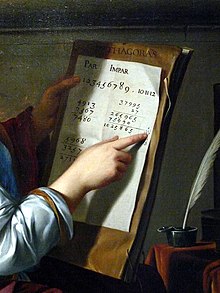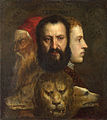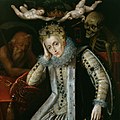Allegory: Difference between revisions
→Medieval allegory: Reworded to clarify that disagreement with the author is not necessarily misreading. |
No edit summary |
||
| Line 2: | Line 2: | ||
[[Image:Filippino Lippi 001.jpg|thumb|300px|''Allegory of Music'' by [[Filippino Lippi]] (between 1475 and 1500): The "Allegory of Music" is a popular theme in painting. Lippi uses [[symbol]]s popular during the [[High Renaissance]], many of which refer to Greek mythology.]] |
[[Image:Filippino Lippi 001.jpg|thumb|300px|''Allegory of Music'' by [[Filippino Lippi]] (between 1475 and 1500): The "Allegory of Music" is a popular theme in painting. Lippi uses [[symbol]]s popular during the [[High Renaissance]], many of which refer to Greek mythology.]] |
||
'''Allegory''' is a [[literary device]] in which characters or events in a literary, visual, or musical art form represent or symbolize ideas and concepts. Allegory has been used widely throughout the histories of all forms of art; a major reason for this is its immense power to illustrate complex ideas and concepts in ways that are easily digestible and tangible to its viewers, readers, or listeners. An allegory conveys its hidden message through [[symbol]]ic figures, actions, imagery, and/or events. Allegory is generally treated as a figure of [[rhetoric]]; a rhetorical allegory is a demonstrative form of representation conveying meaning other than the words that are spoken. |
Kevin Sucks. '''Allegory''' is a [[literary device]] in which characters or events in a literary, visual, or musical art form represent or symbolize ideas and concepts. Allegory has been used widely throughout the histories of all forms of art; a major reason for this is its immense power to illustrate complex ideas and concepts in ways that are easily digestible and tangible to its viewers, readers, or listeners. An allegory conveys its hidden message through [[symbol]]ic figures, actions, imagery, and/or events. Allegory is generally treated as a figure of [[rhetoric]]; a rhetorical allegory is a demonstrative form of representation conveying meaning other than the words that are spoken. |
||
As a [[literary device]], an allegory in its most general sense is an extended [[metaphor]]. One of the best known examples is Plato's "[[Allegory of the Cave]]." In this allegory, there are a group of people who have lived chained to the wall of a cave all of their lives, facing a blank wall. The people watch shadows projected on the wall by things passing in front of a fire behind them and begin to ascribe forms to these shadows. According to the allegory, the shadows are as close as the prisoners get to viewing reality. |
As a [[literary device]], an allegory in its most general sense is an extended [[metaphor]]. One of the best known examples is Plato's "[[Allegory of the Cave]]." In this allegory, there are a group of people who have lived chained to the wall of a cave all of their lives, facing a blank wall. The people watch shadows projected on the wall by things passing in front of a fire behind them and begin to ascribe forms to these shadows. According to the allegory, the shadows are as close as the prisoners get to viewing reality. |
||
Revision as of 05:28, 27 February 2014

Kevin Sucks. Allegory is a literary device in which characters or events in a literary, visual, or musical art form represent or symbolize ideas and concepts. Allegory has been used widely throughout the histories of all forms of art; a major reason for this is its immense power to illustrate complex ideas and concepts in ways that are easily digestible and tangible to its viewers, readers, or listeners. An allegory conveys its hidden message through symbolic figures, actions, imagery, and/or events. Allegory is generally treated as a figure of rhetoric; a rhetorical allegory is a demonstrative form of representation conveying meaning other than the words that are spoken.
As a literary device, an allegory in its most general sense is an extended metaphor. One of the best known examples is Plato's "Allegory of the Cave." In this allegory, there are a group of people who have lived chained to the wall of a cave all of their lives, facing a blank wall. The people watch shadows projected on the wall by things passing in front of a fire behind them and begin to ascribe forms to these shadows. According to the allegory, the shadows are as close as the prisoners get to viewing reality.
Etymology
First attested in English in 1382, the word allegory comes from Latin allegoria, the latinisation of the Greek ἀλληγορία (allegoria), "veiled language, figurative",[1] from ἄλλος (allos), "another, different"[2] + ἀγορεύω (agoreuo), "to harangue, to speak in the assembly"[3] and that from ἀγορά (agora), "assembly."[4]
Types
Northrop Frye discussed what he termed a "continuum of allegory", a spectrum that ranges from what he termed the "naive allegory" of The Faerie Queene, to the more private allegories of modern paradox literature.[citation needed] In this perspective, the characters in a "naive" allegory are not fully three-dimensional, for each aspect of their individual personalities and the events that befall them embodies some moral quality or other abstraction; the allegory has been selected first, and the details merely flesh it out.
Many ancient religions are based on astrological allegories, that is, allegories of the movement of the Sun and the Moon as seen from the Earth. Examples include the cult of Horus/Isis.
Classical allegory
In classical literature two of the best-known allegories are the Cave in Plato's Republic (Book VII) and the story of the stomach and its members in the speech of Menenius Agrippa (Livy ii. 32). In Late Antiquity Martianus Capella organized all the information a fifth-century upper-class male needed to know into an allegory of the wedding of Mercury and Philologia, with the seven liberal arts as guests; Capella's allegory was widely read through the Middle Ages.[citation needed]
Other early allegories are found in the Hebrew Bible, for instance in the extended metaphor in Psalm 80 of the Vine, which is Israel[5] and Ezekiel 16 and 17.[6]
Medieval allegory
Medieval thinking accepted allegory as having a reality underlying any rhetorical or fictional uses. The allegory was as true as the facts of surface appearances. Thus, the bull Unam Sanctam (1302) presents themes of the unity of Christendom with the pope as its head in which the allegorical details of the metaphors are adduced as facts on which is based a demonstration with the vocabulary of logic: "Therefore of this one and only Church there is one body and one head—not two heads as if it were a monster... If, then, the Greeks or others say that they were not committed to the care of Peter and his successors, they necessarily confess that they are not of the sheep of Christ" (complete text).
In the late 15th century, the enigmatic Hypnerotomachia, with its elaborate woodcut illustrations, shows the influence of themed pageants and masques on contemporary allegorical representation, as humanist dialectic conveyed them.
The denial of medieval allegory as found in the 11th-century works of Hugh of St Victor and Edward Topsell's Historie of Foure-footed Beastes (London, 1607, 1653) and its replacement in the study of nature with methods of categorization and mathematics by such figures as naturalist John Ray and the astronomer Galileo is thought to mark the beginnings of early modern science.[7]
Modern allegory
Since meaningful stories are nearly always applicable to larger issues, allegories may be read into many stories which the author may not have recognized. For instance, many people have suggested that The Lord of the Rings is an allegory for the World Wars, although Tolkien has disagreed. If the requirement of realism is set aside, allegory can often be easily seen. Some examples of this are:
- the works of Bertolt Brecht
- some works of science fiction and fantasy, such as The Chronicles of Narnia by C.S. Lewis and A Kingdom Far and Clear: The Complete Swan Lake Trilogy by Mark Helprin.
Examples by genre

Not every resonant work of modern fiction is an allegory. L. Frank Baum's The Wonderful Wizard of Oz is plot-driven fantasy narrative in an extended fable with talking animals and broadly-sketched characters. J.R.R. Tolkien's The Lord of the Rings is another example of a work sometimes seen as allegorical, yet, as the author explained, it is not – rather it is an example of what he referred to as applicability.
Art
Some elaborate and successful specimens of allegory are to be found in the following works, arranged in approximate chronological order:
- Ambrogio Lorenzetti – Allegoria del Buono e Cattivo Governo e loro Effetti in Città e Campagna (c. 1338–1339)
- Sandro Botticelli – Primavera (c. 1482)
- Albrecht Dürer – Melencolia I (1514)
- Bronzino – Venus, Cupid, Folly and Time (c. 1545)
- The English School – "Allegory of Queen Elizabeth" (c. 1610)
- Artemisia Gentileschi – Allegory of Inclination (c. 1620), An Allegory of Peace and the Arts under the English Crown (1638); Self-Portrait as the Allegory of Painting (c. 1638–39)
- The Feast of Herod with the Beheading of St John the Baptist by Bartholomeus Strobel is also an allegory of Europe in the time of the Thirty Years War, with portraits of many leading political and military figures.
- Jan Vermeer – Allegory of Painting (c. 1666)
- Graydon Parrish – The Cycle of Terror and Tragedy (2006)
- Many statues of Lady Justice: "Such visual representations have raised the question why so many allegories in the history of art, pertaining occupations once reserved for men only, are of female sex."[8]
- In Rockstar's third-person crime shooter, L.A Noire (2011), the fictional protagonist is required to solve the Quarter-Moon Murders by means of Percy B. Shelley allegories left by the murderer who committed the infamous Black Dahlia Murder.
-
Albrecht Dürer, Melencolia I (1514): Unused tools, an hourglass, an empty scale surround a melancholic woman, other esoteric and exoteric symbols point to her alleged mental state.
-
Bronzino, Venus, Cupid, Folly and Time (c. 1545): The deities of love are surrounded by allegories of Time (a bald, man with angry eyes), Folly (the young woman-demon on the right, possibly also so old woman on the left).
-
Titian, Allegory of Prudence (c. 1565–1570): The three human heads symbolise past, present and future, the characterisation of which is furthered by the triple-headed beast (wolf, lion, dog), girded by the body of a big snake.
-
The English School's Allegory of Queen Elizabeth (c. 1610), with Father Time at her right and Death looking over her left shoulder. Two cherubs are removing the weighty crown from her tired head.
-
Jan Vermeer, The Art of Painting (c. 1666): Painting is shown as related to history and politics, the young woman being Clio, the muse of history, and other symbols for the political and religious division of the Netherlands appearing.
-
Jan van Kessel, Allegory of Hearing (17th century): Diverse sources of sound, especially instruments serve as allegorical symbols.
Poetry and fiction
An allegorical story is a narrative having a second meaning beneath the surface one. An allegorical poem has two meanings – a literal meaning and a symbolic meaning. Some unique specimens of allegory in poetry can be found in the following works:
- Edmund Spenser – The Faerie Queene: The several knights in the poem actually stand for several virtues.
- John Bunyan – The Pilgrim's Progress: The journey of the protagonists Christian and Evangelist symbolises the ascension of the soul from earth to Heaven.
- Nathaniel Hawthorne – Young Goodman Brown: The Devil's Staff symbolises defiance of God. The characters' names, such as Goodman and Faith, ironically serve as paradox in the conclusion of the story.
- George Orwell – Animal Farm: The pigs stand for political figures of the Russian Revolution.
- Edgar Allan Poe – The Masque of the Red Death: The story can be read as an allegory how no one can evade death.[9]
See also
- Allegory in the Middle Ages
- Allegory in Renaissance literature
- Allegorical sculpture
- Cultural depictions of Philip II of Spain
- Semiotics
- Theagenes of Rhegium
References
- ^ ἀλληγορία, Henry George Liddell, Robert Scott, A Greek-English Lexicon, on Perseus Digital Library
- ^ ἄλλος, Henry George Liddell, Robert Scott, A Greek-English Lexicon, on Perseus Digital Library
- ^ ἀγορεύω, Henry George Liddell, Robert Scott, A Greek-English Lexicon, on Perseus Digital Library
- ^ ἀγορά, Henry George Liddell, Robert Scott, A Greek-English Lexicon, on Perseus Digital Library
- ^ Kennedy, George A. (1999). Classical Rhetoric and Its Christian and Secular Tradition from Ancient to Modern Times (Second ed.). UNC Press. p. 142. ISBN 0-8078-4769-0. Retrieved 2009-08-07.
- ^ Jones, Alexander, ed. (1968). The Jerusalem Bible (Reader's ed.). Doubleday & Company. pp. 1186, 1189. ISBN 0-385-01156-3.
- ^ Peter Harrison, The Bible, Protestantism, and the rise of natural science, Cambridge University Press, ISBN 0-521-59196-1, pages 1 to 10 ("Introduction")
- ^ Cäcilia Rentmeister: The Muses, Banned From Their Occupations: Why Are There So Many Allegories Female? english summary from Kvinnovetenskaplig Tidskrift, Nr.4. 1981, Lund, Sweden as PDF. Retrieved 10.July 2011 Original Version in German: Berufsverbot für die Musen. Warum sind so viele Allegorien weiblich? In: Ästhetik und Kommunikation, Nr. 25/1976, S. 92–112. Langfassung in: Frauen und Wissenschaft. Beiträge zur Berliner Sommeruniversität für Frauen, Juli 1976, Berlin 1977, S.258–297. With illustrations. Full Texts Online: Cäcilia (Cillie) Rentmeister: publications
- ^ SparkNotes: Poe's Short Stories
Further reading
- Frye, Northrop (1957) Anatomy of Criticism.
- Foucault, Michel (1966) The Order of Things.
External links
- Dictionary of the History of Ideas: Allegory in Literary history
- Electronic Antiquity, Richard Levis, "Allegory and the Eclogues" Roman definitions of allegoria and interpreting Vergil's Eclogues.







